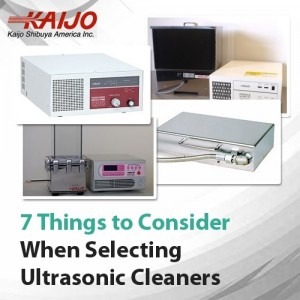7 Things to Consider When Selecting Ultrasonic Cleaners
February 15, 2017
 Ultrasonic cleaning systems can clean many parts better than other cleaning methods because of the intense scrubbing action of cavitation bubbles generated by the ultrasonic waves. While ultrasonic cleaners often work faster and clean more completely than conventional cleaners, they have to be suited for the cleaning application. Facility managers and other decision makers have to be familiar with ultrasonic cleaning system characteristics and features so they can select cleaners that perform up to expectations. Below are seven things to consider when selecting ultrasonic cleaners. Kaijo can help ensure that such considerations result in the selection of systems that will improve cleaning performance.
Ultrasonic cleaning systems can clean many parts better than other cleaning methods because of the intense scrubbing action of cavitation bubbles generated by the ultrasonic waves. While ultrasonic cleaners often work faster and clean more completely than conventional cleaners, they have to be suited for the cleaning application. Facility managers and other decision makers have to be familiar with ultrasonic cleaning system characteristics and features so they can select cleaners that perform up to expectations. Below are seven things to consider when selecting ultrasonic cleaners. Kaijo can help ensure that such considerations result in the selection of systems that will improve cleaning performance.
- What frequency do you need?
The frequency determines the size of the cavitation bubbles and the intensity of the cleaning action. Low frequencies down to about 20 kHz generate comparatively large bubbles for robust cleaning action to remove heavy contamination from rugged parts. Higher frequencies up to 200 kHz generate progressively smaller bubbles for more gentle cleaning of delicate components. The highest frequencies up to the MHz range can be used for cleaning fragile parts such as electronic microcircuits and medical equipment. For flexible applications an ultrasonic cleaner with multiple frequency ranges is useful.
- What cleaning power do you need?
While the ultrasonic frequency determines the bubble size and cleaning intensity, the system’s power in watts gives the overall cleaning capacity. Larger tanks need more power. A cleaning solution tank of about 400 by 400 mm and 250 mm deep requires about 1200 W.
- What size of tank do you need?
The longest dimension of the largest part to be cleaned determines the size of the tank required to clean the part. Kaijo has a variety of standard tank sizes and can build custom tanks for special requirements. If a basket is used, the part has to fit in the basket and the tank has to be slightly larger.
- Do you need a basket?
Baskets fit inside the tank and hold the parts to be cleaned away from the walls and tank floor. Some tanks use the bottom of the tank as a membrane to transmit the ultrasonic waves, causing parts resting on the bottom to vibrate against the tank. This can cause damage to the part and to the tank.
- Do you need heating?
Heating the cleaning solution can speed up cleaning and improve performance when contaminants include grease and oil that can be softened with heat. For contaminants not affected by heat there is little benefit in heating the cleaning bath.
- What cleaning solution should you use?
While industrial ultrasonic cleaners can work with plain water, adding mild detergents to the cleaning solution can improve cleaning performance. In some cases, slightly acidic or slightly alkaline cleaning solutions will help soften or dissolve the contaminants to be removed.
- Do you need sweep mode?
Sweep mode varies the ultrasonic frequency slightly around the set frequency value. For example, a system set to 38 kHz might cycle through 35 to 41 kHz in a continuous variation. Fixed frequencies result in dead spots without bubbles and hot spots with too many bubbles in the cleaning tank. Parts may resonate at a fixed frequency and suffer damage. Sweeping the frequency avoids these problems.
Kaijo can help with considerations such as these to ensure customers select the ultrasonic cleaning system that meets their requirements. Kaijo’s extensive experience in ultrasonic technology and the company’s broad range of ultrasonic cleaning equipment mean that expert advice is available to ensure the systems customers select deliver the improved cleaning performance and increased productivity they expect. If you would like a free consultation on how Kaijo’s ultrasonic cleaners can be used for your cleaning application call Kaijo or email info@kaijo-shibuya.com.





